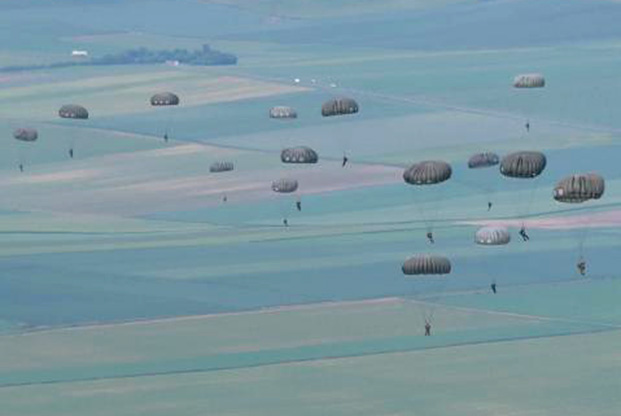
US and allied paratroopers make their descent as one of their many jumps throughout International Jump Week 2018 near Ramstein AB, Germany, May 22, 2018. USAF photo by A1C Kristof J. Rixmann.
International Jump Week
In Europe, US troops and servicemembers from 14 other countries trained together in Germany from May 21-25 as part of International Jump Week.
USAF C-130J aircrew from the 37th Airlift Squadron at Ramstein AB, Germany, flew 29 hours during the event, and 240 US and allied paratroopers jumped from five US Super Hercules as part of the exercise. Polish army Cpl. Bartek Zanik jumped three times during the week and said the experience was “very good.”
“It helped with [international] relationships because every country that participated—USA, Poland, Germany, Netherlands, and Estonia—can all come together to make things better,” said Zanik, who noted that six Polish paratroopers participated.
“You get to change wings and see how other foreign countries operate, how their jumpmasters do things, and then we can compare our procedures to theirs,” US Army SSgt. Triberious Calhoun said. “We learn something from them, and they can learn something from us.”
The exercise was coordinated by the 37th Airlift Squadron and the 435th Contingency Response Group, all based at Ramstein.
ARE FOUR BARELS SINGLE MALT
In late May, the 386th Expeditionary Civil Engineer Squadron emergency management team had the chance to use its skills in a real-world scenario, after 19 unmarked barrels containing mysterious liquids were found in two sites on base.
SSgt. Dallas Christian, 386th ECES emergency management plans noncommissioned officer in charge at the undisclosed location in Southwest Asia, said his team had to go to both sites to examine the barrels and try to figure out what was inside. It was “the first time in my eight-and-a-half years in the Air Force that I actually had to really do my job.”
Still, he said, it wasn’t that different than the exercises the unit normally performs. “We practiced everything we were going to do, and it was smooth and went the way it was supposed to,” Christian said.
MSgt. Terri Adams, 386th ECES emergency management flight chief, said the team’s detectors can break down and identify chemicals, but some of the barrels contained chemical mixtures they could not identify.
However, the team did sample all 19 barrels for harmful chemicals and found no risk to the people on base. Fifteen of the barrels contained corrosive chemicals used to remove rubber from runways, and four barrels were sent to a local lab for additional testing. At press time, their contents had not yet been identified.
_
Jennifer Hlad is a freelance journalist based in the Pacific region and a former Air Force Magazine senior editor.